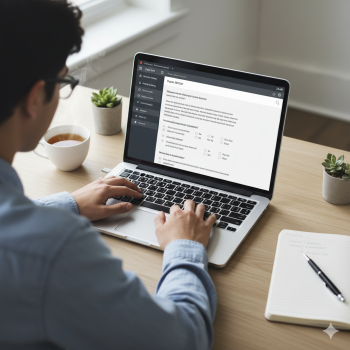Understanding the Big Picture: Does PUCP Require the SAT?
If you’re dreaming of studying at Pontificia Universidad Católica del Perú (PUCP), you probably have a hundred questions spinning in your head. One of the first is: do I need the SAT? The straightforward, helpful answer is: it depends. PUCP primarily runs its own admissions processes and entrance exams, but the role of international standardized tests like the SAT can still be important—especially for international applicants, for scholarship considerations, or for students applying through special admissions pathways.

Why the SAT matters (sometimes)
The SAT is recognized worldwide as a standardized measure of college readiness. For students outside Peru or for those applying to PUCP through international or transfer routes, submitting SAT scores can:
- Provide a common, comparable benchmark of academic skills.
- Strengthen scholarship applications that ask for standardized-test evidence.
- Help admissions officers assess applicants where curricula or grading scales vary.
Even when a university has its own entrance exam, a strong SAT can add weight to your file—showing consistency in performance across national and international measures.
Who should take the SAT if PUCP is your goal?
Here are the common scenarios in which taking the SAT makes sense when aiming for PUCP:
- International students: If you studied outside Peru or are applying from another country, the SAT is often a clear signal of readiness and can simplify comparisons between applicants.
- Transfer applicants: Students transferring from foreign institutions or those applying with international qualifications may use SAT results to supplement their transcripts.
- Scholarship seekers: Some merit-based awards and external scholarships consider or require standardized test scores like the SAT.
- Students who want an extra advantage: Even local applicants sometimes submit SAT scores to strengthen their application or to open doors to international exchange opportunities.
Digital SAT: What to expect and why it’s different
The SAT is now administered in a fully digital format. That matters for how you prepare and how you perform on test day.
Key differences with the Digital SAT
- Shorter total time: The digital test is designed to be more streamlined, which reduces fatigue and improves focus when well-prepared.
- Sectional adaptive format: Parts of the test adjust to your performance, so preparation needs to emphasize consistent accuracy across question types, not just a few high-value questions.
- Tools and tech: Familiarity with on-screen tools (highlighting, digital calculator) is essential—practice on a similar interface helps reduce surprises.
All of this means your study plan should include digital-practice tests, timed sections, and comfort with reading and marking passages on a screen.
Practical score guidance: What should you aim for?
PUCP doesn’t publish a single, universal SAT cutoff for every program (admissions priorities and program competitiveness vary). Instead of chasing a single number, use score targets that align with your goals:
| Applicant Type | Suggested SAT Score Range (Digital SAT, total) | Why this range? |
|---|---|---|
| Strong competitive applicant / scholarship hopeful | 1350–1550 | Maximizes competitiveness for selective programs and merit-based awards. |
| Solid academic applicant (broad list of programs) | 1200–1340 | Demonstrates strong readiness and complements a solid GPA and activities. |
| Supplemental evidence / early prep | 1000–1190 | Useful as supplemental evidence, especially for less competitive programs or early practice. |
Remember: these ranges are suggested targets to help you plan. PUCP evaluates applications holistically—your grades, portfolio (for creative programs), letters of recommendation, interview performance, and fit with program goals all matter.
Language and testing logistics
PUCP programs are primarily taught in Spanish, and many admissions processes are conducted in Spanish as well. This means:
- If you’re an international student, ensure you meet any Spanish proficiency requirements—these may be separate from SAT expectations.
- If you plan to use the SAT as part of your file, include other materials that show your Spanish skills (school transcripts, language certificates, or a placement exam if required).
Make sure to check whether PUCP requires official score submission through the College Board (official score reports) or if they accept self-reported scores during early application steps. When in doubt, request official guidance from PUCP’s admissions office.
How to weave the SAT into your PUCP application strategy
Treat the SAT as one strand in a woven application tapestry. Here’s a practical plan you and your family can follow:
12–18 months before application
- Explore PUCP’s admissions pages for the specific faculty or program you want—requirements vary by department.
- Choose a testing timeline for the Digital SAT: practice early, then schedule an official test date about 6–9 months before your application deadline.
- Work on Spanish proficiency if needed—enrollment in language courses or certifications can be helpful.
6–9 months before application
- Take at least one full-length digital practice SAT under timed conditions.
- Identify content weaknesses and start a focused revision plan with weekly goals.
- If you’re considering scholarships, research the eligibility criteria and whether SAT scores are used.
Final 3 months
- Take a final official or proctored practice test with the same digital environment you’ll face on test day.
- Polish application materials: essays (in Spanish if required), recommendations, and any portfolio items.
- Plan score submission—know the College Board code or PUCP instructions for sending official reports.
Study strategies that actually work for the Digital SAT
Preparing for the Digital SAT is as much about habit and test-smarts as it is about content. Here’s a strategy that balances both:
- Mix skills and timed practice: Spend some sessions on deep content work (algebra, grammar rules, evidence-based reading) and others on full sections under timed conditions.
- Focused error logs: Keep a running list of mistake-types (e.g., algebraic manipulation errors, inference errors in reading). Revisit this list weekly.
- Digital fluency: Practice with the digital tools you’ll use on test day. Time spent learning to navigate the platform reduces anxiety and saves minutes.
- Simulate test-day conditions: Use uninterrupted blocks, follow the same breaks, and practice with the same materials format so there are no surprises.
- Review the scoring mindset: Because the digital SAT sections are adaptive in parts, aim for steady accuracy rather than wild guessing.

How parents can be supportive without adding stress
Parents play a huge role—without being the ‘pressure police’. Here’s how to keep things steady and encouraging:
- Help create structure: Support a consistent study schedule and quiet study spaces.
- Normalize setbacks: Low practice scores are data, not destiny. Help your student analyze results calmly and plan next steps.
- Balance life and study: Encourage sleep, exercise, and breaks—mental stamina matters as much as content recall.
- Explore support options: Consider 1-on-1 tutoring, small group workshops, or targeted review for weak areas—tailored help often accelerates progress.
How personalized tutoring (like Sparkl) can fit naturally into your plan
Many students benefit from guided, personalized tutoring—especially when preparing for the Digital SAT while navigating a foreign-admissions system. Sparkl-style support typically offers:
- One-on-one guidance that meets the student where they are academically and emotionally.
- Tailored study plans focusing on the student’s specific weaknesses—so practice time becomes high-yield.
- Expert tutors who understand both SAT demands and the context of applying to international universities like PUCP.
- AI-driven insights to track progress, adjust practice problem sets, and identify persistent error patterns faster than manual review alone.
Used thoughtfully, this kind of support can boost confidence, sharpen skills, and free families from the guesswork of “what to study next.”
Application checklist: SAT-related items to confirm
Before you click submit on your PUCP application, use this checklist to make sure your SAT-related details are covered:
- Have you confirmed whether your chosen PUCP program accepts or requires SAT scores?
- Did you obtain official score reports from the College Board if required?
- Have you aligned SAT submission deadlines with PUCP’s application calendar?
- If Spanish proficiency is needed, have you arranged the necessary tests or documents?
- Have you included SAT scores in scholarship applications where relevant?
Common pitfalls and how to avoid them
Families often stumble over a few recurring issues—here’s how to sidestep them:
- Assuming the same rules apply to all programs: Admission rules can vary by faculty. Always check the program-specific requirements.
- Waiting too long to test: Schedule a test date early enough to allow a retake if needed, and plan a buffer for score reporting.
- Neglecting language prep: A great SAT won’t replace required Spanish language readiness for most PUCP programs.
- Relying on one practice test: Multiple, spaced practice tests give the most reliable progress picture.
Example timeline: A practical 9-month prep plan
Here’s a sample calendar you can adapt. It assumes an application deadline in the late part of an admissions cycle—adjust the months to match your deadlines.
| Months Before Application | Tasks |
|---|---|
| 9–12 | Explore PUCP program requirements; take a diagnostic Digital SAT practice test; build a study schedule. |
| 6–8 | Start focused content review; take timed section practice once a week; begin polishing Spanish language skills. |
| 3–5 | Take a full-length digital practice test monthly; work with a tutor for targeted weaknesses; draft application essays. |
| 1–2 | Take an official Digital SAT or final practice under test-day conditions; gather official score reports; finalize application materials. |
Real-world examples and comparisons
To illustrate, imagine two applicants to the same PUCP program:
- María, a local student: Strong GPA, stellar Spanish essays, no SAT submitted, excelled on PUCP’s native entrance exam. Her application is robust because it aligns with local expectations and the program’s evaluation metrics.
- Daniel, an international applicant: Comparable academic record, but different curriculum. He submits a strong Digital SAT score (within the higher suggested range), a Spanish proficiency certification, and a carefully translated transcript. The SAT makes Daniel’s application easier to evaluate alongside local applicants.
Both pathways can be successful—what matters is alignment: match your documents and test scores to the admissions context that best represents you.
Final advice: Be strategic, not frantic
Applying to PUCP is a blend of demonstrating academic readiness, language ability, and program fit. The SAT can be a helpful piece of evidence for many applicants, especially those coming from outside Peru or those seeking scholarships. But it’s not the only factor—and a great application balances standardized-test evidence with strong essays, recommendations, and clear academic intent.
If you find yourself unsure about next steps, consider a short consultation with a knowledgeable tutor or counselor who understands both the Digital SAT and the Peruvian admissions landscape. Personalized programs—like the tailored 1-on-1 guidance and AI-driven progress tracking offered by services such as Sparkl—can make your preparation more efficient and less stressful. They’re especially useful when you’re balancing language prep, a busy school schedule, and application deadlines.
Next steps checklist
- Confirm program-specific admissions requirements directly with PUCP admissions.
- Decide whether to take the Digital SAT based on your profile (international status, scholarships, transfer situation).
- Set a testing and study timeline with at least one practice test every 4–6 weeks.
- Consider targeted tutoring to address weaknesses and to simulate the digital experience.
- Prepare Spanish materials and verify how PUCP wants scores or certificates submitted.
Closing thoughts
Applying to Pontificia Universidad Católica del Perú is an exciting step. Whether the SAT is central to your application or a helpful supplement, approach preparation with calm strategy: set realistic score targets, practice in the digital environment, and make sure your Spanish-language readiness and program fit are clear. With steady practice, thoughtful planning, and the right support, you’ll put forward an application that truly reflects your readiness and potential.
Good luck—and remember: the journey to PUCP is not just about a number on a page. It’s about the story you craft in your application, the growth you’ve shown in your academic life, and the clear reasons you have for wanting to study there. Let the SAT be part of that story—preparedly, confidently, and on your own terms.












No Comments
Leave a comment Cancel